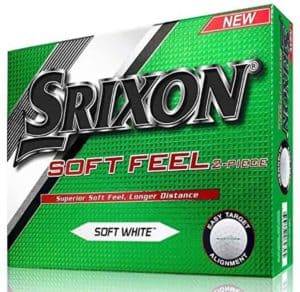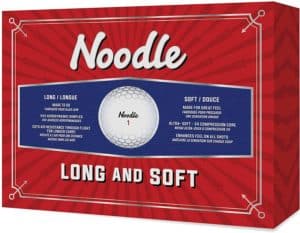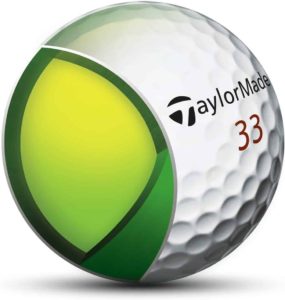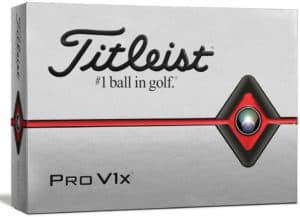For starters, you could buy balls that you don’t need. Either they don’t fit your goals, or your game is inappropriate for enjoying all the balls.
An even more expensive ball is not always a long ball. For example, a Pro V1x is no longer an affordable golf ball. The most costly ball, in general, will allow you to turn the ball much more around the greens. It has more “feel”, as you may have heard before.
An even more expensive ball will allow you to be more specific with your irons and wedges. The ball won’t spin as much as a more affordable, harder golf ball. Pitch and chips will be “inspected” (stopped on the greens) faster than a cheaper, one-piece golf ball. Finally, the ball will undoubtedly feel much better when you hit it, with each club, with a more expensive golf ball.
However, all of the essential things I’ve outlined provide virtually no pros for someone who doesn’t have an excellent golf game. A beginner or an average handicapped person will certainly not benefit much from an expensive golf ball. Finding a good “budget” golf ball that performs almost as well would undoubtedly be better.
Let’s be honest: they will probably all end up in the water anyway!
If you’re a beginner, the golf ball rarely makes any difference. You have to discover a lot of points and stimulate your activity with many techniques just before you consider paying a fortune for a ball. It would be best if you used balls that are already used.
Rather than buying one of the highest quality golf balls on the market, I would advise you to switch to a similar ball at a reduced price. Some very good replacement golf balls out there will set you back almost fifty percent from their competitors.
One more point: if you usually buy golf balls in stores, you will probably pay more than you need. Do you want to spend $5 a dozen to support your club or local retail store? Okay, fine, don’t worry! If you’re looking to save money, I recommend buying the best and cheapest golf balls on Amazon.
Srixon Soft Feel 2 Piece
 It was a golf ball that I liked the most in high school. I didn’t have much money to spend on golf, and I was surprised when I received these balls as a birthday present.
It was a golf ball that I liked the most in high school. I didn’t have much money to spend on golf, and I was surprised when I received these balls as a birthday present.
At first, I wasn’t very excited because I hadn’t played many Srixon balls, but I was pleased when I took them all to the golf course. The ball seemed to be a high-quality ball without the skin of the club, and its flight was just right and far away. It reacted relatively well around the greens compared to a golf ball three times faster.
I don’t just like to buy new brand-name golf balls at the best price. But if I ever had to, I would choose this ball 100%.
If you want to spend $20 on 12 golf balls, this is the ball for you. It usually sells for around $15 for a dozen balls. It’s a real boost. Thinking about each ball, it’s rarely more than a dollar each. At the 2018 US Open, they sold for about $10 per set, so you might want to hold out for that one more time if you’re certainly not in a hurry.
If you want to save even more, buy a larger or slightly used set.
Callaway SuperSoft Golf Balls
 If you want to buy a top-quality golf ball, even if your budget is tight, if you want to save money, and if you have a good alternative, look at Callaway Supersoft balls.
If you want to buy a top-quality golf ball, even if your budget is tight, if you want to save money, and if you have a good alternative, look at Callaway Supersoft balls.
They’re soft on the clubface, giving a fantastic feel when hitting. They spin very well on the greens, so you can’t roll them.
It seems to me that they perform very well in terms of proximity. The only Cons are that I think my wedges scraped the balls well, but I got excellent volume from all the wedges. In general, they are a fantastic alternative to a Callaway Chrome Soft.
For about $20 and free shipping, it’s a bargain hard to beat. However, if you’re looking for the hardest ball on the market, you might want to appear elsewhere.
Best Titleist Pro V1x Alternative
Technical balls are simply balls that usually have a small physical imperfection. It’s mostly the imprint of the golf ball. Even if there is a small variation in the resemblance, the ball is marked with “practice”.
I have ended up turning many players by playing with practice balls. You can use them easily in tournaments because they are treated like logo balls.
If you can overcome the significant word in all capital letters on your ball, then get started and save money now!
Just a quick note: training balls should not be confused with restored balls. Restored balls are covered with a new layer of coating and will likely fly away differently than their new counterparts. However, the training balls correspond to the real thing, with unobservable acne. Titleist would certainly never sell a ball, even a practice ball, that would be significantly affected by the imperfection that affects its performance.
Another option for you who want to save money while still playing the best ball on the market is to purchase a large quantity of AAAA balls. AAAA balls are certainly not in satisfactory condition, but AAAA balls are also expensive. AAAA golf balls are, therefore, the perfect combination. You can get a ball for just over a dollar, which is much better than practice balls.
My beloved site for buying used golf balls at the best price has reasonable offers for new buyers. Even if you are not a new customer, they offer incredible professional tournaments for about 20-30% off all orders.
Noodle Golf Balls
 If you don’t care much about the feeling around the greens and prefer to have a few extra backyards in your fairways, choose Noodle golf balls.
If you don’t care much about the feeling around the greens and prefer to have a few extra backyards in your fairways, choose Noodle golf balls.
Noodle, owned by TaylorMade, has a wonderful reputation among novices and high handicap golfers. The ball is supposed to fly very far.
It will undoubtedly be a little harder to influence, but it will do the job.
For less than a dollar a ball, it’s the perfect ball to overtake your good friends on a tight budget.
I also knew a player who was an extremely professional golfer in high school who used this ball for all rounds except for some major tournaments. He saved a lot of money throughout high school, and most of the group bought expensive new Bridgestone and Titleist balls. I certainly wouldn’t advise creating a modification like this for events, but it shows just how valuable a golf ball Noodle is.
The Taylormade Project (a) – The Largest (High-Quality Tour) Golf Ball for Amateurs
 The green and white package of Taylormade projects a golf ball. Some of the most effective golf balls for the average golfer.
The green and white package of Taylormade projects a golf ball. Some of the most effective golf balls for the average golfer.
The Taylormade (a) project golf ball is one of the most effective alternatives for the average level golfer looking for more spin around the green. This golf ball is developed as a “temperate” excursion-grade golf ball. It can be matched to the Titleist NXT Tour for every rate and performance and also features a low center of gravity. The reduced compression ratio of 70 is indicated to help golfers swing at speeds below 100 mph, but all of its other qualities are designed for reactionary performance.
This golf ball could be shaped for those who are trying to shape the ball and will undoubtedly keep a high rotation rate around the greens. This is not implied for high handicap novices as the twist created by the urethane cover, and the mantle will undoubtedly cause the ball to cut or snag if you don’t hit it right. This is the best golf ball for you if you want to take your activity from the 90s and 80s to something lower. Consider the Srixon Soft Feeling if you’re looking for a cheaper, more straightforward golf ball that entirely takes advantage of the range.
Ease of use and excellence in rotation
Let’s take a closer look at why Project Taylormade (a) is one of the best golf balls for mid-level golfers. This golf ball was created for enthusiasts who want to play more than just a basic ball. The Taylormade (a) is a three-piece golf ball with a low compression center, a jacket, and a high-performance urethane cover. It will move from the appropriate to the right and vice versa when hit correctly and will also go over the greens. In designing this golf ball, Taylormade didn’t focus on distance. With a higher-value ball, golf ball manufacturers have the luxury of using better components to increase performance. That’s what Taylor has precisely managed to do here.
Why this golf ball performs so well
Project Taylormade (a) has a rating point that is a little larger than many of the other best golf balls for golf enthusiasts. This much higher rate point means that Taylormade has incorporated more technology into this golf ball than the others. Additional technology suggests more performance.
The cover/hull
The Taylormade Project (a) includes a thin layer of high-performance urethane. If you have read the comments of our other customers, you now understand that this indicates even more twists and a softer feel. Essentially, every premium golf ball is coated with a layer of urethane. This material is soft and sticky and produces a fantastic reaction around the greens.
The Core
The high-quality ball of the standard circuit usually has a compression rating of 100, with a compression rating of 70. The core of the Taylormade project (a) has minimal compression. This benefits golf enthusiasts with swing speeds of less than one hundred miles per hour. The lower the compression score, the greater the distance the ball travels.
Mantle
Like other balls that can be provided among the best golf balls, the Taylormade project coat (a) is suggested to decrease the driver’s spin and increase the wedge’s torsion. The technology of the golf ball makes it react like a tour ball around the greens. If you’re looking for a comparison, this golf ball will have a slightly less twist than a Pro V1x.
FINDING THE BEST GOLF BALL: THE COMPLETE GUIDE
Suppose you found yourself clicking on this article. In that case, you are probably asking yourself, “How do I find the perfect golf ball that will lower my Handicap Index and give me the ideal ball trajectory with the farthest possible distance?
While this is a noble question, it is a very understandable one. All golfers want a quick solution to their game without practice. But believe it or not, the golf ball you play can make a big difference in your game, even if you are an occasional golfer with a high handicap. However, that doesn’t mean you must run to Titleist and buy the Pro-V1. Don’t assume this is the “quick fix” we’re talking about; trust us, your wallet will thank you later.
Just like golf clubs, clothing, and even golf shoes, there is a golf ball designed specifically for your game, and most of the time, that doesn’t mean you have to buy the most popular or expensive ball on the market. So if you’re unsure which ball to use, don’t fall into the hype and think about your game before making your first purchase. Although we call this a “quick fix”, it may not be as quick or miraculous as you think. But, if you research and think hard enough about what’s essential to your game, the right ball will be beneficial and make the game more enjoyable.
Pro Tip: Consider buying one sleeve at a time and test it on the golf course to see how the ball feels and how your game reacts before purchasing the first dozen.
WHAT IS THE GOLF BALL MADE OF?
The main difference in the construction of golf balls on the market is the number of layers and the material used to make them. The layers vary from two to five. Since the beginning of the game, when golf balls were made initially from feathers in a leather cover, the golf ball industry has become a constantly evolving science. (Check out this great video from the United States Golf Association on the evolution of the golf ball).
Developing a golf ball requires a lot of consideration and research into aerodynamics and learning what it takes to create spin, drag, and distance from a golf ball when it is hit at different speeds. You will always see a synthetic cover made of different materials depending on the results the manufacturers want in a ball filled with several layers of synthetic composite material. Each variant of the golf ball is designed specifically for particular swing angles and speeds, or in other words, for different skill levels.
The golf balls you hit on a driving range are usually single-layer because they are cheap. Unless you are a member of an exclusive country club, the driving range ball is not expected to deliver performance and quality. However, quality can be felt when you get to the three- or four-layer golf ball, especially from a more experienced player. When you have more layers, you can have the best of both worlds, a soft, forgiving envelope but a complex center for a high-performance shot.
When you look at the different models of golf balls, each one has a different level of spin. In general, the more experienced the player, the more spin you can potentially incorporate into your game and enjoy high-spin golf balls. The face of the golf ball creates spin – the material it’s made of, the number of dimples, etc. – and is a function of the ball’s shape. Low spin allows for more roll and less variation in the ball’s direction while in flight. A high spin creates the opposite, more lift, but more chance of bending the ball – intentionally or unintentionally!
A determining factor is the compression level when looking for a golf ball that matches your skill level. This website, created by the Golf Information Guide, offers details on the compression level of every golf ball on the market. It will tell you how fast your swing must be compatible with that particular compression level.
For example, the ball mentioned above, the Pro-V1, has an 80’s compression, which means that you need a swing speed of more than 100 mph to reach the full potential of the ball. This means that to compress the ball and notice any improvement in distance or control, you would have to hit the ball consistently at 100 mph. In other words, you might as well hit a single-layer golf ball as you would on a practice course.
So, to find the golf ball that will improve your game and where you can see a difference, we recommend that you match the level of compression and softness of the cover to the speed of your swing. When we enter the world of more skilled players, we can begin to discuss spin, layers, and level of control.
SKILL LEVEL – BOGEY-GOLFER OR BIRDIE-MACHINE?
HIGH HANDICAP GOLFER
For players new to the game who need a little more forgiveness and accuracy, an excellent place to start is to play a softer golf ball with a less complex core ( fewer layers ). You don’t need to worry about spinning the ball around the green at this level, and it would be essential to look at which ball feels best. The ideal golf ball should offer: a straight trajectory, extra distance, and less spin to avoid aggravating your draw or occasional fade.
As much as we look at the pros’ benefits of hanging it 20 yards around a tree on the green – on purpose – accomplishing this may not be in your future, so why buy the ball that works for that specific, technical, more difficult shot?
Callaway Supersoft: This ball has a “supersoft” cover for the best possible feel, but it also has a two-layer core, which allows for a straighter, more consistent ball flight. Most importantly, the compression level is low, allowing the lower swing speed to hit the ball and take advantage of the extra length on the tee. Not to mention that a dozen golf balls (with the yellow option as well – very useful for the lost ball issue) cost only about $20.
LOW HANDICAP, COMPETITIVE PLAYER
When you are a competitive golfer with a lower handicap, it is more common to have the ability to control the ball by yourself and be creative. So this would be an excellent opportunity to experiment with more layers in your golf ball. When you put more layers in the ball you play, your accuracy may decrease, but you may notice that playing with a curve will feel much easier.
You’ll also notice an increase in spin, which may allow you to play better on the greens and get a satisfying stop when the ball lands on the green. But keep paying attention to the speed of your swing and the level of compression you want.
TaylorMade TP5: More and more professional golfers are switching to the TP5 (Rickie Fowler recently switched to the TP5 and just won the 2021 Waste Management Open), so we recommend that the more experienced player with a high swing speed try this one. It is highly responsive on the greens to turn and stop on a dime, and especially, its length at the tee (if you swing over 100 mph) has been very favorable.
However, just because you are a low handicap player doesn’t mean that the only ball for your game is a hardcover with more than two or three layers.
If you prefer accuracy with the straightest possible ball flight, and you’re OK with a little more roll on the greens, choosing a two-layer ball or maybe a lower compression ball is terrible.
Titleist NXT Tour: This is perhaps one of the most underestimated golf balls, as its big brother is the “#1 ball on the world tours”. It requires a higher swing speed but still has that satisfying, softer feel in a more forgiving golf ball. You can manipulate the ball to spin a little, but not as much as a “pro” level golf ball. It cooperates more than anything else with the forehand.
We recommend that price is not the answer. You may find that a used ball, like the Callaway Supersoft or Titleist NXT Tour, is the most productive ball that best suits your game – and that’s the point! Finding your ball, regardless of brand and price, is all that matters. So, good luck, try everything, and make sure your ball is far, straight, and always the closest to the pin.
STYLE OF PLAY – WHAT IS YOUR “TASTE”?
Another way to decide what type of golf ball you should look for is what you are looking for on the golf course. While we all would like to have a perfect game, we have to choose our battles. So, choosing your ball would be very beneficial, depending on which part of your game you feel comfortable with – or where you want to feel more confident. That way, you’ll have a better chance of seeing results if you focus on a specific aspect of your game.
DISTANCE FROM THE TEE
If you want to get the maximum distance with your driver, pay attention to the level of compression and the speed of your swing. You’ll want to take advantage of this compression and ensure you can reach the full potential of the ball.
SHAPING SHOTS IN THE FAIRWAY
By 2021, this could be considered a traditional way to play golf. With pros like Dustin Johnson jumping over 300 yards (he plays TaylorMade TP5x), there’s no need to do tricks around trees or worry about bunkers. Why worry when you can just hit over them? But, if it’s creativity that attracts you, or if you’re naturally not that far from the tee, finding a ball that allows you to hit in shape would be very beneficial. We recommend that you look for a ball with more layers and maybe a little more spin factor, which allows you to make such complex shots.
CONTROL THE BALL ON AND AROUND THE GREENS
It’s very similar to the previous style of play, but if you want to spin the ball in your short game and have ultimate control, finding a ball that allows a lot of rotation will best suit your game. Keep in mind that this is not for the beginner player or someone who doesn’t have as much experience in spinning the ball (on purpose). There is also less accuracy with many spins, which means a less forgiving ball. So be careful, but enjoy the pros if you have the necessary skills!
There are LOTS of golf balls on the market in 2021, and navigation is not getting any easier.
Even for a professional athlete, golf balls are constantly being tested by trying many different makes and models before making a decision. Because it’s so complex, even the most skilled golfer takes a long time to choose a ball. Not every aspect of a golf ball is a definitive answer about the person it is made for. For example, we have mentioned the softcover several times here, and this preference could apply to almost any type of golfer. So take a good look at your game and identify what you want to improve or perfect.
